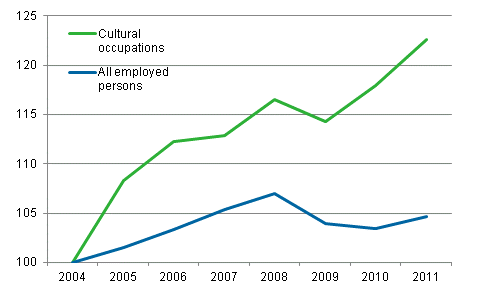Published: 16 August 2012
Employment in the field of culture has developed favourably over the 2000s
According to Statistics Finland's Labour Force Survey, employment has grown faster in cultural occupations and cultural industries than the employment of all occupations and industries. In cultural industries employment has gone up by close on eight per cent from 2004 to 2010 and in cultural occupations by over 22 per cent from 2004 to 2011. Over the same period, employment has increased by nearly five per cent.
Development of employment among those in cultural occupations and all employed persons from 2004 to 2011, 2004=100

Cultural industries also employ others than those working in cultural occupations, which explains the difference in the development of employment in cultural occupations and industries.
Of occupations, employment improved most among graphic, art and craft designers and related artists, up by over 60 per cent. Employment of those in artistic occupations increased by around 14 per cent and that of journalists by over five per cent.
Of industries, employment in advertising grew by nearly 60 per cent from 2004 to 2010. Contracting industries are publishing (-2.4 per cent) and printing and related services (-14.2 per cent).
The Labour Force Survey (LFS) collects statistical data on the participation in work, employment, unemployment and activity of persons outside the labour force among the population aged between 15 and 74. The LFS data collection is based on a random sample drawn twice a year from Statistics Finland’s population database. The monthly sample consists of some 12,000 persons and the data are collected with computer-assisted telephone interviews. Based on the information provided by the respondents, a picture emerges of the activities of the entire population aged between 15 and 74.
A person is employed if he/she has during the survey week been in gainful employment for at least one hour against pay in money or fringe benefits, or to make a profit, or has been temporarily absent from work. Persons absent from work during the survey week are classified as employed if the reason for absence is maternity or paternity leave or own illness or the absence has lasted for under three months. Employed persons can be employees, self-employed or unpaid workers in enterprises of a family member. The definition of employed also includes those employed by means of grants. The concepts and definitions used in the survey comply with the recommendations of the ILO, the International Labour Organisation of the UN, and the regulations of the European Union on official statistics. The current data content of the Labour Force Survey is based mainly on the EU Regulations concerning Labour Force Surveys (577/98, 2257/2003 and 430/2005). On the EU level, labour force in the field of culture is described by means of the Labour Force Survey. A detailed description of the EU Labour Force Survey is available at: http://epp.eurostat.ec.europa.eu/portal/page/portal/employment_unemployment_lfs/introduction .
Source: Cultural statistics 2010, Statistics Finland
Inquiries: Kaisa Weckström 09 1734 2348, kulttuuri.tilastokeskus@stat.fi
Director in charge: Riitta Harala
- Reviews
- Tables
-
Tables in databases
Pick the data you need into tables, view the data as graphs, or download the data for your use.
- Figures
Updated 16.8.2012
Official Statistics of Finland (OSF):
Culture [e-publication].
ISSN=2341-7404. Cultural Employment in Finland 2010. Helsinki: Statistics Finland [referred: 19.4.2024].
Access method: http://www.stat.fi/til/klt/2010/01/klt_2010_01_2012-08-16_tie_001_en.html

